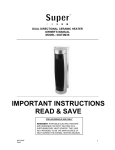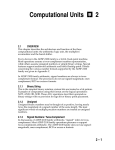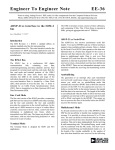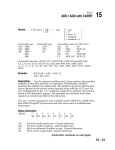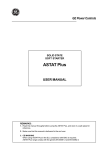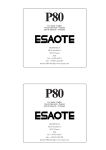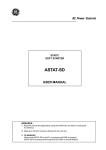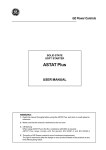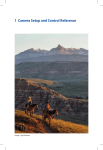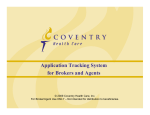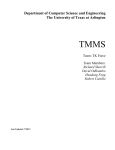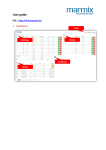Download ADSP-2100 Family User`s Manual, Division Exceptions
Transcript
Division Exceptions
B.1
B
DIVISION FUNDAMENTALS
The ADSP-2100 family processors’ instruction set contains two
instructions for implementing a non-restoring divide algorithm. These
instructions take as their operands twos-complement or unsigned
numbers, and in sixteen cycles produce a truncated quotient of sixteen
bits. For most numbers and applications, these primitives produce the
correct results. However, there are certain situations where results
produced will be off by one LSB. This appendix documents these
situations, and presents alternatives for producing the correct results.
Computing a 16-bit fixed point quotient from two numbers is
accomplished by 16 executions of the DIVQ instruction for unsigned
numbers. Signed division uses the DIVS instruction first, followed by
fifteen DIVQs. Regardless of which division you perform, both input
operands must be of the same type (signed or unsigned) and produce a
result of the same type.
These two instructions are used to implement a conditional add/subtract,
non-restoring division algorithm. As its name implies, the algorithm
functions by adding or subtracting the divisor to/from the dividend. The
decision as to which operation is perform is based on the previously
generated quotient bit. Each add/subtract operation produces a new
partial remainder, which will be used in the next step.
The phrase non-restoring refers to the fact that the final remainder is not
correct. With a restoring algorithm, it is possible, at any step, to take the
partial quotient, multiply it by the divisor, and add the partial remainder
to recreate the dividend. With this non-restoring algorithm, it is necessary
to add two times the divisor to the partial remainder if the previously
determined quotient bit is zero. It is easier to compute the remainder
using the multiplier than in the ALU.
B.1.1
Signed Division
Signed division is accomplished by first storing the 16-bit divisor in an X
register (AX0, AX1, AR, MR2, MR1, MR0, SR1, or SR0). The 32-bit
dividend must be stored in two separate 16-bit registers. The lower 16-bits
must be stored in AY0, while the upper 16-bits can be in either AY1, or
AF.
B–1
B Division Exceptions
The DIVS primitive is executed once, with the proper operands (ex. DIVS
AY1, AX0) to compute the sign of the quotient. The sign bit of the quotient
is determined by XORing (exclusive-or) the sign bits of each operand. The
entire 32-bit dividend is shifted left one bit. The lower fifteen bits of the
dividend with the recently determined sign bit appended are stored in
AY0, while the lower fifteen bits of the upper word, with the MSB of the
lower word appended is stored in AF.
To complete the division, 15 DIVQ instructions are executed. Operation of
the DIVQ primitive is described below.
B.1.2
Unsigned Division
Computing an unsigned division is done like signed division, except the
first instruction is not a DIVS, but another DIVQ. The upper word of the
dividend must be stored in AF, and the AQ bit of the ASTAT register
must be set to zero before the divide begins.
The DIVQ instruction uses the AQ bit of the ASTAT register to determine
if the dividend should be added to, or subtracted from the partial
remainder stored in AF and AY0. If AQ is zero, a subtract occurs. A new
value for AQ is determined by XORing the MSB of the divisor with the
MSB of the dividend. The 32-bit dividend is shifted left one bit, and the
inverted value of AQ is moved into the LSB.
B.1.3
Output Formats
As in multiplication, the format of a division result is based on the format
of the input operands. The division logic has been designed to work most
efficiently with fully fractional numbers, those most commonly used in
fixed-point DSP applications. A signed, fully fractional number uses one
bit before the binary point as the sign, with fifteen (or thirty-one in double
precision) bits to the right, for magnitude.
If the dividend is in M.N format (M bits before the binary point, N bits
after), and the divisor is O.P format, the quotient’s format will be
(M-O+1).(N-P-1). As you can see, dividing a 1.31 number by a 1.15
number will produce a quotient whose format is (1-1+1).(31-15-1) or 1.15.
Before dividing two numbers, you must ensure that the format of the
quotient will be valid. For example, if you attempted to divide a 32.0
number by a 1.15 number the result would attempt to be in
(32-1+1).(0-15-1) or 32.-16 format. This cannot be represented in a 16-bit
register!
B–2
Division Exceptions B
In addition to proper output format, you must insure that a divide
overflow does not occur. Even if a division of two numbers produces a
legal output format, it is possible that the number will overflow, and be
unable to fit within the constraints of the output. For example, if you
wished to divide a 16.16 number by a 1.15 number, the output format
would be (16-1+1).(16-15-1) or 16.0 which is legal. Now assume you
happened to have 16384 (0x4000) as the dividend and .25 (0x2000) as the
divisor, the quotient would be 65536, which does not fit in 16.0 format.
This operation would overflow, producing an erroneous results.
Input operands can be checked before division to ensure that an overflow
will not result. If the magnitude of the upper 16 bits of the dividend is
larger than the magnitude of the divisor, an overflow will result.
B.1.4
Integer Division
One special case of division that deserves special mention is integer
division. There may be some cases where you wish to divide two integers,
and produce an integer result. It can be seen that an integer-integer
division will produce an invalid output format of (32-16+1).(0-0-1), or
17.-1.
To generate an integer quotient, you must shift the dividend to the left one
bit, placing it in 31.1 format. The output format for this division will be
(31-16+1).(1-0-1), or 16.0. You must ensure that no significant bits are lost
during the left shift, or an invalid result will be generated.
B.2
ERROR CONDITIONS
Although the divide primitives for the ADSP-2100 family work correctly
in most instances, there are two cases where an invalid or inaccurate result
can be generated. The first case involves signed division by a negative
number. If you attempt to use a negative number as the divisor, the
quotient generated may be one LSB less than the correct result. The other
case concerns unsigned division by a divisor greater than 0x7FFF. If the
divisor in an unsigned division exceeds 0x7FFF, an invalid quotient will
be generated.
B.2.1
Negative Divisor Error
The quotient produced by a divide with a negative divisor will generally
be one LSB less than the correct result. The divide algorithm implemented
on the ADSP-2100 family does not correctly compensate for the twoscomplement format of a negative number, causing this inaccuracy.
B–3
B Division Exceptions
There is one case where this discrepancy does not occur. If the result of the
division operation should equal 0x8000, then it will be correctly
represented, and not be one LSB off.
There are several ways to correct for this error. Before changing any code,
however, you should determine if a one-LSB error in your quotient is a
significant problem. In some cases, the LSB is small enough to be
insignificant. If you find it necessary have exact results, two solutions are
possible.
One is to avoid division by negative numbers. If your divisor is negative,
take its absolute value and invert the sign of the quotient after division.
This will produce the correct result.
Another technique would be to check the result by multiplying the
quotient by the divisor. Compare this value with the dividend, and if they
are off by more than the value of the divisor, increase the quotient by one.
B.2.2
Unsigned Division Error
Unsigned divisions can produce erroneous results if the divisor is greater
than 0x7FFF. You should not attempt to divide two unsigned numbers if
the divisor has a one in the MSB. If it is necessary to perform a such a
division, both operands should be shifted right one bit. This will maintain
the correct orientation of operands.
Shifting both operands may result in a one LSB error in the quotient. This
can be solved by multiplying the quotient by the original (not shifted)
divisor. Subtract this value from the original dividend to calculate the
error. If the error is greater than the divisor, add one to the quotient, if it is
negative, subtract one from the quotient.
B.3
SOFTWARE SOLUTION
Each of the problems mentioned in this Appendix can be compensated for
in software. Listing 1 shows the module divide_solution. This code can be
used to divide two signed or unsigned numbers to produce the correct
quotient, or an error condition.
In addition to correcting the problems mentioned, this module provides a
check for division overflow and computes the remainder following the
division.
B–4
Division Exceptions B
Since many applications do not require complete error checking, the code
has been designed so you can remove tests that are not necessary for your
project. This will decrease memory requirements, as well as increase
execution speed.
The module signed_div expects the 32-bit dividend to be stored in
AY1&AY0, and the divisor in AX0. Upon return either the AR register
holds the quotient and MR0 holds the remainder, or the overflow flag is
set. The entire routine takes at most twenty-seven cycles to execute. If an
exception condition exists, it may return sooner. The first two instructions
store the dividend in the MR registers, the absolute value of the
dividend’s MSW in AF, and the divisor’s absolute value in AR.
The code block labeled test_1 checks for division by 0x8000. Attempting to
take the absolute value of 0x8000 produces an overflow. If the AV flag is
set (from taking the absolute value of the divisor), then the quotient is –
AY1. This can produce an error if AY1 is 0x8000, so after taking the
negative of AY1, the overflow flag is checked again. If it is set control is
returned to the calling routine, otherwise the remainder is computed. If it
is not necessary to check for a divisor of 0x8000, this code block can be
removed.
The code block labeled test_2 checks for a division overflow condition. The
absolute value of the divisor is subtracted from the absolute value of the
dividend’s MSW. If the divisor is less then the dividend, it is likely an
overflow will occur. If the two are equal in magnitude, but different in
sign, the result will be 0x8000, so this special case is checked. If your
application does not require an overflow check, this code block can be
removed. If you decide to remove test_2 be sure to change the JUMP
address in test_1 to do_divs, instead of test_2.
After error checking, the actual division is performed. Since the absolute
value of the divisor has been stored in AR, this is used as the X-operand
for the DIVS instruction. 15 DIVQ instructions follow, computing the rest
of the quotient. The correct sign for the quotient is determined, based on
the AS flag of the ASTAT register. Since the MR register contains the
original dividend, the remainder can be determine by a multiply subtract
operation. The divisor times the quotient is subtracted from MR to
produce the remainder in MR0.
The last step before returning is to clear the ASTAT register which may
contain an overflow flag produced during the divide.
B–5
B Division Exceptions
The subroutine unsigned_div is very similar to signed_div. MR1 and AF are
loaded with the MSW of the dividend, MR0 is loaded with the dividend
LSW and the divisor is passed into AR. Since unsigned division with a
large divisor (> 0x7FFF) is prohibited, the MSB of the divisor is checked. If
it contains a one, the overflow flag is set, and the routine returns to the
caller. Otherwise test_11 checks for a standard divide overflow.
In test_11 the divisor is subtracted from the MSW of the dividend. If the
result is less then zero division can proceed, otherwise the overflow flag is
set. If you wish to remove test_11, be sure to change the JUMP address in
test_10 to do_divq.
The actual unsigned division is performed by first clearing the AQ bit of
the ASTAT register, then executing sixteen DIVQ instructions. The
remainder is computed, after first setting MR2 to zero. This is necessary
since MR1 automatically sign-extends into MR2. Also, the multiply must
be executed with the unsigned switch. To ensure that the overflow flag is
clear, ASTAT is set to zero before returning.
In both subroutines, the computation of the remainder requires only one
extra cycle, so it is unlikely you would need to remove it for speed. If it is
a problem to have the multiply registers altered, remove the
multiply/subtract instruction just before the return, and remove the
register transfers to MR0 and MR1 in the first two multifunction
instructions. Be sure to remove the MR2=0; instruction in the unsigned_div
subroutine also.
.MODULE/ROM
Divide_solution;
{
This module can be used to generate correct results when using the divide primitives
of the ADSP-2100 family. The code is organized in sections. This entire module can
be used to handle all error conditions, or individual sections can be removed to
increase execution speed.
Entry Points
signed_div Computes 16-bit signed quotient
unsigned_div Computes 16-bit unsigned quotient
Calling Parameters
AX0 = 16-bit divisor
AY0 = Lower 16 bits of dividend
AY1 = Upper 16 bits of dividend
B–6
Division Exceptions B
Return Values
AR = 16-bit quotient
MR0 = 16-bit remainder
AV flag set if divide would overflow
Altered Registers
AX0, AX1, AR, AF, AY0, AY1, MR, MY0
Computation Time: 30 cycles
}
.ENTRY
signed_div, unsigned_div;
signed_div:
MR0=AY0,AF=AX0+AY1;
MR1=AY1, AR=ABS AX0;
{Take divisor’s absolute value}
{See if divisor, dividend have
same magnitude}
test_1:
IF NE JUMP test_2;
ASTAT=0x4;
RTS;
{If divisor non-zero, do test 2}
{Divide by zero, so overflow}
{Return to calling program}
test_2:
IF NOT AV JUMP test_3;
{If divisor 0x8000, then the}
AY0=AY1, AF=ABS AY1;
{quotient is simply -AY1}
IF NOT AV JUMP recover_sign;
ASTAT=0x4;
{0x8000 divided by 0x8000,}
RTS;
{so overflow}
test_3:
AF=PASS AF;
IF NE JUMP test_4;
AY0=0x8000;
ASTAT=0x0;
JUMP recover_sign;
{Check for division overflow}
{Not equal, jump test 4}
{Quotient equals -1}
{Clear AS bit of ASTAT}
{Compute remainder}
test_4:
AF=ABS MR1;
AR=ABS AX0;
AF=AF-AR;
IF LT JUMP do_divs;
ASTAT=0x4;
RTS;
{Get absolute of dividend}
{Restore AS bit of ASTAT}
{Check for division overflow}
{If Divisor>Dividend do divide}
{Division overflow}
Listing B.1 Division Error Routine
(continues on next page)
B–7
B Division Exceptions
do_divs:
DIVS
DIVQ
DIVQ
DIVQ
DIVQ
DIVQ
DIVQ
DIVQ
recover_sign:
MY0=AX0,AR=PASS AY0;
IF NEG AR=-AY0;
MR=MR-AR*MY0 (SS);
RTS;
{Put quotient into AR}
{Restore sign if necessary}
{compute remainder dividend neg}
{Return to calling program}
unsigned_div:
MR0=AY0, AF=PASS AY1;
MR1=AY1, AR=PASS AX0;
{Move dividend MSW to AF}
{Is MSB set?}
test_10:
IF GT JUMP test_11;
ASTAT=0x4;
RTS;
{No, so check overflow}
{Yes, so set overflow flag}
{Return to caller}
test_11:
AR=AY1-AX0;
IF LT JUMP do_divq;
ASTAT=0x4;
RTS;
{Is divisor<dividend?}
{No, so go do unsigned divide}
{Set overflow flag}
do_divq:
ASTAT=0;
DIVQ AX0;
DIVQ AX0;
DIVQ AX0;
DIVQ AX0;
DIVQ AX0;
DIVQ AX0;
DIVQ AX0;
DIVQ AX0;
{Clear AQ flag}
{Do the divide}
uremainder:
AY1, AR;
AR; DIVQ
AR; DIVQ
AR; DIVQ
AR; DIVQ
AR; DIVQ
AR; DIVQ
AR; DIVQ
DIVQ
DIVQ
DIVQ
DIVQ
DIVQ
DIVQ
DIVQ
DIVQ
DIVQ AR;
AR;
AR;
AR;
AR;
AR;
AR;
AR;
AX0;
AX0;
AX0;
AX0;
AX0;
AX0;
AX0;
AX0;
MR2=0;
MY0=AX0, AR=PASS AY0;
MR=MR-AR*MY0 (UU);
RTS;
.ENDMOD;
Listing B.1 Division Error Routine
B–8
{Compute sign of quotient}
{MR0 and MR1 previous set}
{Divisor in MYO, Quotient in AR}
{Determine remainder}
{Return to calling program}








